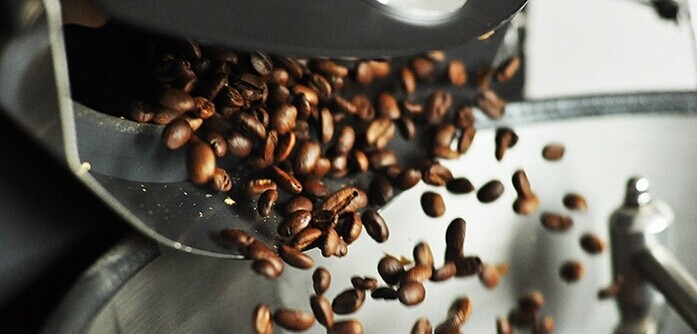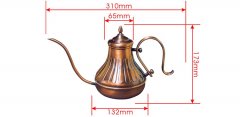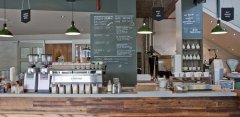Italian Coffee Common sense Coffee roasting South Italian, favorite, Northern Italian
How to decide which baking degree to use for espresso? how shallow and deep espresso beans can be baked and still have good espresso performance? And how do you use these different baking styles to add features to your ripe bean retail business? If you have the same problem, please take a look at it if you want to get the answer.

Italian coffee beans mixed with beans
When we talk about baking beans for espresso, we are actually talking about the science of mixed beans. The highest sweetness of various coffee beans from different countries appears at different baking points, so roasters must find a balance between baking and mixing beans in order to make a good cup of espresso. This knowledge begins with the degree of baking and the selection of beans, as well as the baking master's own taste acuteness. If you give full play to these three key points, you will have a good chance to produce espresso with a balanced export feel and a pleasant flavor.
When using Northern Italian roasting, the bean selection process is the key point. You must select the coffee beans with the lowest acidity at this baking degree. For example, the Brazilian beans you use are the least sour out of 10 Brazilian beans, but if you go deeper, if you want to bake the Italian formula, you don't need to consider the acidity. 50% of the Brazilian beans can meet this requirement. If you want to use the deepest southern Italian baking, then every Brazilian can. Generally speaking, the Northern Italian recipe must use Arabica beans with mild flavor and low acidity. The classic recipe is Moka Java, which combines Yemeni Moka and Java Arabica beans. However, there is another popular and widely used alternative recipe, which is Ethiopia and Sumatra.
The choice of beans in Chinese-Italian formula is more flexible, but you may have to choose a few beans with a strong style, such as Ethiopia. Many beans with high acidity, such as Costa Rica and Kenya, reach their peak when baked in Chinese and Italian style.
Southern Italian baking is too deep, so you have to use a very strong recipe, usually rough and strong African beans are suitable for use, such as Burundi or Ethiopia. I personally think that when you enter such a deep baking degree of French baking, you have a wide range of flexibility in choosing beans, because at this time, most of the qualities of coffee beans are baked off.
North Italian coffee roasting
In the case of relatively shallow baking (popular around Milan), this recipe produces a cup of espresso that tastes like sugar water. Personally, I think this kind of formula is the best combination of sweetness and baked drupe flavor, but it is the most likely to cause problems in the extraction stage. The Northern Italian formula has the greatest potential to produce sweet espresso, but it is very easy to screw up during extraction, thick and sweet dry aroma, which means that the flavor is the most complex and fragile, and the carbonization is relatively low. After years of practical experience, I have found that the North Italian formula, its aromatic substances after the action of hot water, is the most fragile, if the extraction is not done properly, it will make the espresso which is supposed to have a sweet smell, which may become too sour / bitter or astringent.
As a baking retailer, when you use most of these more fragile recipes, you will face the challenge of insufficient stability in the cup when brewing. Due to the lack of baking flavor substrate in the Northern Italian formula, if your bar staff is a little careless, the espresso will be easy to detect defects, especially when mixed with milk; when extracted by experts, when mixed with milk, it will highlight the strong caramel flavor in the espresso. To me, this caramel flavor is the style and characteristics of the Northern Italian formula.
Because the coffee beans of Northern Italian formula are less carbonated, their caramel flavor and regional flavor characteristics account for a high proportion. It is a great challenge to retain these rich characteristics during cooking, especially in the stability of cooking water temperature. If the cooking water temperature changes too much (up and down more than 2 ℃), caramel flavor will be the first to be sacrificed. Then came the dull yellowish crema outflow. If the cooking water temperature is stable (up and down less than 1 ℃), the crema will appear reddish brown. But the reddish-brown crema does not mean that the caramel flavor can survive after brewing, even under a very stable cooking water temperature, it is often sour espresso, then the water temperature may be low (at sea level, the ideal cooking water temperature is 95 degrees Celsius, the measuring point is near the coffee cake). On the thermostat in my store, I found that the sweeter the espresso, the easier it is for their crema to fall apart.
The Northern Italian recipe has many other challenges for professional brewers. For example, the machine must be cleaned very carefully, because the beans of the Northern Italian formula are particularly easy to absorb the smell from the coffee machine, and if the machine is not cleaned properly, the espresso will be uncomfortably bitter, between charred toast and smelly socks after exercise. In addition, it must be stored in the shape of the whole bean and flipped and mixed from time to time. Coffee beans are stored in a sealed and opaque container at a temperature of about 12 degrees Celsius, just like red wine. In the case of pure Arabica beans, the beans must be used within 3-10 days after baking, when the crema status of espresso is the most complete. If a high proportion of Robasta is used in the formula, the peak of crema may be prolonged, but it must be noted that Robasta beans can provide very thick crema, but it is not helpful for sweetness at all. Under the northern Italian baking degree, the vast majority of Robasta beans show astringent or woody taste, while good Arabica beans show sweet taste.
The bar staff must be very skilled in order to correctly cook the North Italian formula. If there is any error in cooking or filling, resulting in the "channel" effect, the water flows quickly through this crack, the sweet molecules are destroyed, and the composition of the whole aromatic compound flowing into the cup is out of balance. Finally, the whole cup of espresso is occupied by astringency. In addition, the bar staff must also be careful not to put the espresso for too long. The cooked espresso must be mixed with milk as soon as possible. When making cappuccino, the sweet molecule of espresso is one of the important ingredients to form foam, but this ingredient will soon fade, and ceramic cups must also be preheated to preserve the espresso structure.
One of the keys to getting this seductive sweetness is the flow rate. To deal with this variable, the bar player must first carefully adjust the grinding scale. If the flow rate is too fast, it will be sour and astringent, and if the flow rate is too slow, it will be scorched and bitter. The goal of our store is to extract for 25 seconds, and the state of flow must be like a "mouse tail".
It may take years to cook a cup of Northern Italian espresso, but if you finally succeed and your store happens to be in an area where more customers like the taste, your business may be much better than other ripe bean retailers in the same area. However, if your goal is to open any type of chain store, do not choose this kind of northern Italian baking, practice cooking and try to fail a lot of times, you might as well choose a deeper baking formula, customers are more acceptable. The Northern Italian recipe is more suitable for baking retailers who are interested in the spirit of craftsmanship to sell. A talented coffee lover with a great passion for coffee will be fascinated by the successful espresso of this Northern Italian recipe. Once you have successfully mastered the main points of the Northern Italian recipe, then you are almost unrivalled in the industry.
Chinese and Italian coffee roasting
When we bake deeper and more sugar begins to be carbonized or burned, this is called Italian baking, which is usually popular around Florence with this degree of espresso. This kind of formula produces slightly darker beans with a bitter flavor. But the baking degree is not deep enough to burn out all the flavor characteristics of the producing area. The formula of Chinese and Italian style is mainly another type of balance, that is, the combination of bitterness, remaining sugar and flavor characteristics of the producing area. There is more or less a hint of smoky aftertaste in Chinese-Italian espresso.
The Italian formula is extracted with an unstable boiling water temperature (most espresso machines on the market have a water temperature change of more than 14 degrees Celsius), the espresso of the Italian formula still has a stable performance, so this type of formula is the most suitable for general baking retailers and, of course, for high pole roasters to sell. The advantage of Chinese-Italian formula is that in case the bar staff is slightly negligent and the amount of espresso flows down exceeds the standard, the coffee of Chinese-Italian formula will still not have the defects of sour, thin texture, or astringency, and will only lack some sweetness compared with the beans of Northern Italian formula (even if the Chinese-Italian formula is carefully brewed, the sweetness will not be better than the carefully brewed Northern Italian formula espresso). In the Chinese-Italian formula, because the degree of carbonization is slightly higher, and the carbon itself is a chemically stable ingredient, it doesn't matter what stage of machine is used to brew this kind of formula, or it doesn't matter if you are not careful when making it. Anyway, there must be bitterness caused by carbonization in the cup.
The roasting depth of Italian coffee is getting deeper and deeper to the south for a reason. One hypothetical theory is that the amount of spices used by residents varies due to different climates, as well as their taste preferences. At first, residents in the north had a lower average temperature, which made it easier to preserve food and meat. in contrast, the weather in the south was hotter, so residents had to rely on a lot of spices to preserve their food. Many anthropologists believe that this has a certain impact on the taste preferences of residents in different regions, and may also explain why southerners prefer more intensive foods and drinks. The application of this theory to coffee explains why southerly coffee tastes more bitter. Of course, these are just theories, which can not be applied in a pluralistic society like the United States. However, if most of your customers belong to the southern ethnic group, you may find that they prefer the taste of deeper-roasted coffee.
South Italian coffee roasting
Southern Italian baking is the deepest baking stage of espresso beans. In this kind of espresso, bitterness / carbon taste is the main flavor, overshadowing most sweetness and regional flavor characteristics. Napoli is the representative region in Southern Italy, where you can find the deepest baked espresso in the world, leaving only a little sweetness and regional flavor characteristics. If you bake deeper, all that's left is probably carbon and bitterness. Because the bitter taste of espresso at this depth is very strong, it will cover most of the sweetness, but the flavor persistence at this time is the highest, which also increases the fault tolerance rate in cooking. With stylized training and machine, plus a professional bar trainer, this kind of espresso can be done. South Italian baked beans are very suitable for use in small espresso bar or small chain coffee shops. Using any coffee machine, you can make a stable espresso.
The baristas in Napoli always keep the half-ounce espresso cups that have just been squeezed out in hot water, and people on the Italian side will add a rub of sugar and stir it quickly to swallow it. It is inferred that Southern Italian-baked espresso may have to be extracted (ristretto) in a very short time, because there is less sugar in coffee beans, and the tradition has been to squeeze a smaller dose in order to balance the sugar and bitterness in the cup. Many people think that this baking method, coupled with this brewing method in Napoli, is the most perfect match in the world, but this combination may not be popular in the United States, because Americans prefer to drink large cups of coffee without bitterness!
Large baking enterprise vs small baking retailer
The secret to running a successful coffee shop chain is to provide products of stable quality, no matter which branch you buy, the quality of the products you buy must be fixed. The same is true when it comes to coffee retailing. As the roasting depth gets deeper and the sugar in coffee beans becomes more carbonated, we get a batch of French-roasted coffee beans. Why is it called French baking? This is because once extracted, these coffee beans are added to a large bowl of milk and served as breakfast for the French. French roasting is the most common baking degree chosen by most corporate roasting retailers. With enough milk and sugar, the beverage made from beans that are deeper than Southern Italian roast will taste a bit like smoked oysters (not entirely unacceptable), and in most markets, many customers will think that this kind of coffee is a great "strong taste" coffee.
Why do roasters of large coffee roasters prefer French roasting? The reason is simple: it doesn't take much effort to get a drink of stable quality. At this depth, the flavor, sugar and acid of the coffee beans are burned in the roaster, so you don't have to spend too much effort to choose the coffee beans, anyway, the taste is the same in the end, in addition, the freshness does not need to be taken into account, because carbon will not become stale!
I'm not contemptuous of the espresso quality of large chains, but I'm trying to explain how competitive a small roaster retailer has in this situation. In order to survive in this industry, you have to make your own store have its own unique style, and espresso has to have its own characteristics. These are the requirements for small coffee roasting retailers to survive, because these require high technology.
Only those who spend a lot of time and effort to improve the quality of espresso can stand the test of time and survive in today's boutique coffee market. If you can move forward with this goal, you are a promoter of coffee culture: coffee art that combines aesthetics, depth, and technology.
Important Notice :
前街咖啡 FrontStreet Coffee has moved to new addredd:
FrontStreet Coffee Address: 315,Donghua East Road,GuangZhou
Tel:020 38364473
- Prev

SCAA hand brewed coffee standard water temperature reference boutique coffee
Practical parameters of water temperature 88 ℃ ~ 94 ℃ (medium to shallow roasting) 82 ℃ ~ 87 ℃ (re-roasting or medium-deep roasting) it is difficult to maintain a constant temperature in the brewing process, and the water temperature will continue to drop, but this is also valuable. As long as the drop in the water temperature of the hand pot can be controlled within 4 ℃, many coffee aromatics will show variable vibrations because of their different molecular weight and polarity.
- Next

How to improve the quality of a cup of American coffee? How do you make American coffee?
How to improve the quality of a cup of American coffee? Today we are going to talk about how to make a good cup of American coffee. The practice of American coffee is indeed very simple: American coffee = water + espresso. However, there is a great controversy in the coffee industry during the production process. One is to use the Italian machine to make a cup of light coffee for a long time, and the other is to make Espresso first.
Related
- Beginners will see the "Coffee pull flower" guide!
- What is the difference between ice blog purified milk and ordinary milk coffee?
- Why is the Philippines the largest producer of crops in Liberia?
- For coffee extraction, should the fine powder be retained?
- How does extracted espresso fill pressed powder? How much strength does it take to press the powder?
- How to make jasmine cold extract coffee? Is the jasmine + latte good?
- Will this little toy really make the coffee taste better? How does Lily Drip affect coffee extraction?
- Will the action of slapping the filter cup also affect coffee extraction?
- What's the difference between powder-to-water ratio and powder-to-liquid ratio?
- What is the Ethiopian local species? What does it have to do with Heirloom native species?

